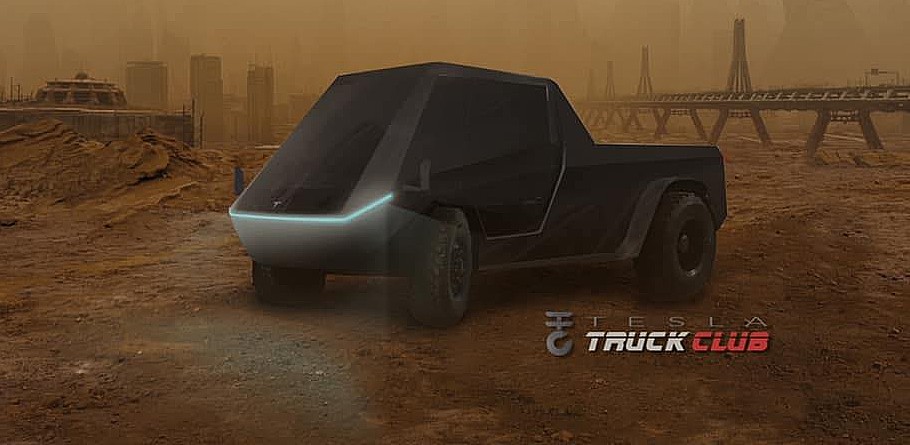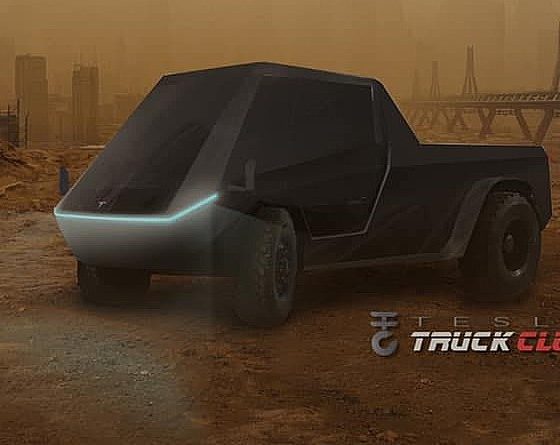A new all-electric cyberpunk truck may be hitting the streets in the somewhat near future, and it’s being designed and built by Tesla, the company most responsible for the current electric vehicle revolution.
CEO Elon Musk tweeted a teaser image of a part of the Tesla Truck following last week’s Model Y unveiling (after no one noticed during the unveiling), but there wasn’t much to be said about what was actually being portrayed. Musk didn’t provide additional details, and the image itself wasn’t any obvious part of a vehicle, but that hasn’t stopped the Tesla community from tapping into its collective imagination. Several renderings of the upcoming electric truck have been created, and here we’ve compiled a few of our faves.
In a somewhat conventional version that incorporates Tesla’s Aero Wheels, this photo imagines the teaser pic as a bed cover. The glowing trim seems to simply have an aesthetic purpose.
Going for a more robotic vision of the future truck, a render posted by an account naming itself representative of the “Tesla Truck Club” community displayed the teaser pic as the front of the vehicle. The glow lines appear to take the place of traditional headlights, and the truck cab completely boxes in the hood/frunk portions.
Finally, the same Twitter account also posited that the teaser pic was just a more detailed version of a truck render already released by Tesla during the Tesla Semi unveiling. The overall suggestion is that the truck will just be a variation of the Tesla Semi itself, using the Semi’s architecture.
Gathering a few clues about the final Tesla truck look obviously came to order prior to the rendering designs. Perhaps the most well-known description given of the truck is a tie-in to Blade Runner. Musk has famously described it as a vehicle that would not be “out of place” in the film. If you haven’t seen it, “futuristic”, “cyberpunk”, “dystopia”, and “80s” are all the adjectives you need.
The tech-inspired CEO took to Twitter last year to ask the community what it would like to see in a Tesla Truck. Plenty of suggestions followed from the online crowd, but even more importantly were the further truck details provided by Musk:
- Dual motor all-wheel drive
- Crazy torque
- Suspension that dynamically adjusts for load
- Power outlets allowing use of heavy duty, 240V, high power tools in field (no generator needed)
- Cameras
- Onboard neural net
- Ultrasonics
Other details that were revealed over the last year include six seats, 400-500 miles of range per charge, and 300,000 lbs of towing capacity (yes, that’s 300 thousand pounds of torque). Regardless of what the Tesla Truck will look like, its features are certainly impressive, and members of the traditional truck crowd will likely take its credentials seriously once they see what it can do for themselves.
In an appearance on Recode’s Decode Podcast, Musk touted that Tesla’s cyberpunk truck was awesome, amazing, and heart-stopping; however, he also acknowledged that some reconfiguration might be in order if the design isn’t appealing to a wide enough audience. “If there’s only a small number of people that like that truck, I guess we’ll make a more conventional truck in the future,” he said. Musk has also commented about the “look” of Tesla’s truck, warning that it might be “too futuristic for most people, but [he] love[s] it”.
If the Tesla Truck is designed to be compelling enough to do well in the market, the company will have its latest industry disruption at hand. The truck market is currently dominated by vehicles like the Ford’s F-Series which it sold nearly 1 million of in 2018, Chevy’s Silverado, and Dodge’s Ram, each of which sold over half a million vehicles in 2018. All-electric startup Rivian has also noticed the possible potential in the truck market, and has its own R1T truck scheduled for deliveries in 2020. It should also be noted that Ford itself is looking to produce an all-electric version of its popular F-Series as well.
So, when will everyone get to see the actual Tesla Truck? According to Musk, later this year.

News
Tesla China quietly posts Robotaxi-related job listing
Tesla China is currently seeking a Low Voltage Electrical Engineer to work on circuit board design for the company’s autonomous vehicles.

Tesla has posted a new job listing in Shanghai explicitly tied to its Robotaxi program, fueling speculation that the company is preparing to launch its dedicated autonomous ride-hailing service in China.
As noted in the listing, Tesla China is currently seeking a Low Voltage Electrical Engineer to work on circuit board design for the company’s autonomous vehicles.
Robotaxi-specific role
The listing, which was shared on social media platform X by industry watcher @tslaming, suggested that Tesla China is looking to fill the role urgently. The job listing itself specifically mentions that the person hired for the role will be working on the Low Voltage Hardware team, which would design the circuit boards that would serve as the nervous system of the Robotaxi.
Key tasks for the role, as indicated in the job listing, include collaboration with PCB layout, firmware, mechanical, program management, and validation teams, among other responsibilities. The role is based in Shanghai.
China Robotaxi launch
China represents a massive potential market for robotaxis, with its dense urban centers and supportive policies in select cities. Tesla has limited permission to roll out FSD in the country, though despite this, its vehicles have been hailed as among the best in the market when it comes to autonomous features. So far, at least, it appears that China supports Tesla’s FSD and Robotaxi rollout.
This was hinted at in November, when Tesla brought the Cybercab to the 8th China International Import Expo (CIIE) in Shanghai, marking the first time that the autonomous two-seater was brought to the Asia-Pacific region. The vehicle, despite not having a release date in China, received a significant amount of interest among the event’s attendees.
Elon Musk
Elon Musk and Tesla AI Director share insights after empty driver seat Robotaxi rides
The executives’ unoccupied tests hint at the rapid progress of Tesla’s unsupervised Robotaxi efforts.

Tesla CEO Elon Musk and AI Director Ashok Elluswamy celebrated Christmas Eve by sharing personal experiences with Robotaxi vehicles that had no safety monitor or occupant in the driver’s seat. Musk described the system’s “perfect driving” around Austin, while Elluswamy posted video from the back seat, calling it “an amazing experience.”
The executives’ unoccupied tests hint at the rapid progress of Tesla’s unsupervised Robotaxi efforts.
Elon and Ashok’s firsthand Robotaxi insights
Prior to Musk and the Tesla AI Director’s posts, sightings of unmanned Teslas navigating public roads were widely shared on social media. One such vehicle was spotted in Austin, Texas, which Elon Musk acknowleged by stating that “Testing is underway with no occupants in the car.”
Based on his Christmas Eve post, Musk seemed to have tested an unmanned Tesla himself. “A Tesla with no safety monitor in the car and me sitting in the passenger seat took me all around Austin on Sunday with perfect driving,” Musk wrote in his post.
Elluswamy responded with a 2-minute video showing himself in the rear of an unmanned Tesla. The video featured the vehicle’s empty front seats, as well as its smooth handling through real-world traffic. He captioned his video with the words, “It’s an amazing experience!”
Towards Unsupervised operations
During an xAI Hackathon earlier this month, Elon Musk mentioned that Tesla owed be removing Safety Monitors from its Robotaxis in Austin in just three weeks. “Unsupervised is pretty much solved at this point. So there will be Tesla Robotaxis operating in Austin with no one in them. Not even anyone in the passenger seat in about three weeks,” he said. Musk echoed similar estimates at the 2025 Annual Shareholder Meeting and the Q3 2025 earnings call.
Considering the insights that were posted Musk and Elluswamy, it does appear that Tesla is working hard towards operating its Robotaxis with no safety monitors. This is quite impressive considering that the service was launched just earlier this year.
Elon Musk
Starlink passes 9 million active customers just weeks after hitting 8 million
The milestone highlights the accelerating growth of Starlink, which has now been adding over 20,000 new users per day.

SpaceX’s Starlink satellite internet service has continued its rapid global expansion, surpassing 9 million active customers just weeks after crossing the 8 million mark.
The milestone highlights the accelerating growth of Starlink, which has now been adding over 20,000 new users per day.
9 million customers
In a post on X, SpaceX stated that Starlink now serves over 9 million active users across 155 countries, territories, and markets. The company reached 8 million customers in early November, meaning it added roughly 1 million subscribers in under seven weeks, or about 21,275 new users on average per day.
“Starlink is connecting more than 9M active customers with high-speed internet across 155 countries, territories, and many other markets,” Starlink wrote in a post on its official X account. SpaceX President Gwynne Shotwell also celebrated the milestone on X. “A huge thank you to all of our customers and congrats to the Starlink team for such an incredible product,” she wrote.
That growth rate reflects both rising demand for broadband in underserved regions and Starlink’s expanding satellite constellation, which now includes more than 9,000 low-Earth-orbit satellites designed to deliver high-speed, low-latency internet worldwide.
Starlink’s momentum
Starlink’s momentum has been building up. SpaceX reported 4.6 million Starlink customers in December 2024, followed by 7 million by August 2025, and 8 million customers in November. Independent data also suggests Starlink usage is rising sharply, with Cloudflare reporting that global web traffic from Starlink users more than doubled in 2025, as noted in an Insider report.
Starlink’s momentum is increasingly tied to SpaceX’s broader financial outlook. Elon Musk has said the satellite network is “by far” the company’s largest revenue driver, and reports suggest SpaceX may be positioning itself for an initial public offering as soon as next year, with valuations estimated as high as $1.5 trillion. Musk has also suggested in the past that Starlink could have its own IPO in the future.










